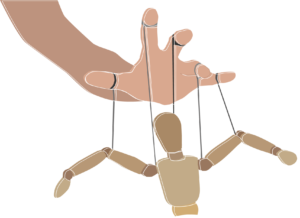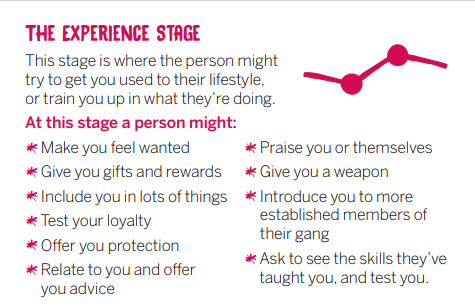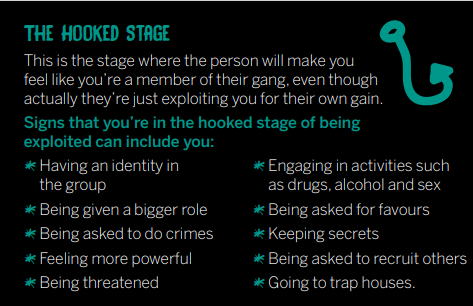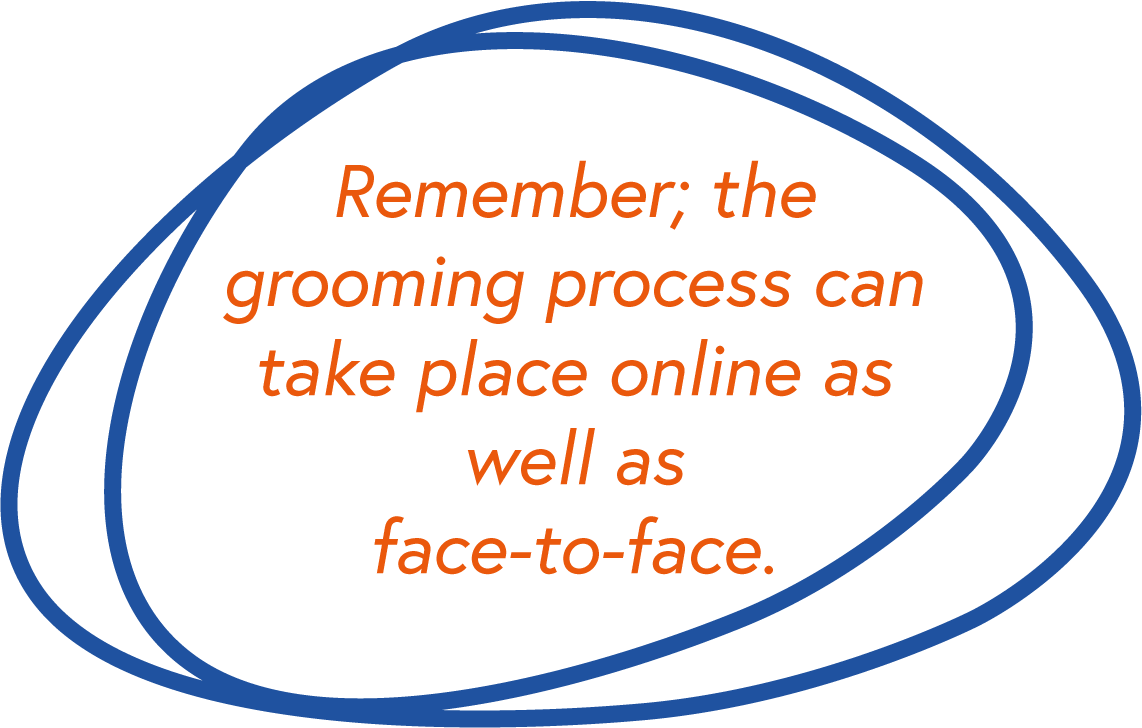Child exploitation: What does it mean?

Exploitation is a type of child abuse, it is never the fault of the child. It is often characterised by an imbalance of power, exchange, and (the restriction or absence of) consent.
Exploitation occurs when an individual or group takes advantage of an imbalance of power to coerce, control, manipulate, or deceive a child (under the age of 18 years):
(a) in exchange for something the victim needs or wants and/or
(b) for the financial advantage or increased status of the perpetrator or facilitator.
Money, gifts, accommodation, affection, status, food, drugs, or alcohol may be freely given to the child but then they will be expected to engage in sexual and/or criminal activities in return.
What does that look like?
Exploitation is where a person (adult or peer) or group forces, tricks, or manipulates a child into doing something for them.
Money, gifts, accommodation, affection, attention, status, food, drugs, or alcohol may be given to the child but then they will be expected to engage in sexual and/or criminal activities in return. The child often trusts the person exploiting them and may not know that what is happening to them is exploitation.
A child may be being exploited even if they appear to agree to the activity. They may be scared of what will happen if they do not do what their abuser says.
Sometimes young people can be used to exploit other children through peer groups or gangs.
It is a serious crime and the young people and families around them are victims, even if they may not recognise themselves as such.


Types of child exploitation:
Child exploitation is complex; there are many different elements and often more than one can be happening at any one time. Click below to learn about the different types of exploitation. Further information about some of the language and terminology used around exploitation can be found on our Jargon Buster page.
Child Criminal Exploitation (CCE) is when a child or young person is groomed by being given things, like gifts, drugs, money, status, attention, and affection. This is usually in exchange for carrying out a criminal activity for the benefit of the adult or peer carrying out the abuse. County Lines is a form of child criminal exploitation in which the abuser grooms and manipulates children into drug dealing. The ‘line’ refers to the mobile phone line which is used to control the young person delivering and selling the drugs.
More information can be found at the Children’s Society by clicking here.
Child Sexual Exploitation (CSE) is a type of sexual abuse. It happens when children and young people are tricked into doing something sexual; sometimes receiving something in return like love, affection, money, drugs or alcohol. This can happen face to face but also online; where children can be persuaded or forced to send or post sexually explicit images of themselves, film or stream sexual activities, or have sexual conversations.
More information can be found a the NSPCC by clicking here.
Trafficking is where children and young people are tricked, forced, or persuaded to be moved or transported and then exploited, forced to work, perform criminal or sexual activities, or sold. Trafficking can occur anywhere a young person is moved or transported regardless of the distance they are moved (not just across countries or counties).
Children can be trafficked for:
– sexual and criminal exploitation
– benefit fraud
– forced marriage
– domestic slavery like cleaning, cooking, and childcare
– forced labour in factories or agriculture
– committing crimes, like theft, working on cannabis farms, or moving drugs
Modern Slavery is the exploitation of people who have been forced, tricked, or intimidated into a life of labour and servitude. For example:
A young person who is forced to work or serve – through fear and threats of violence
A young person is owned or controlled by an abuser who uses mental or physical abuse to control them.
A young person is physically constrained or has restrictions placed on his/her freedom of movement
Modern Slavery is linked to Human Trafficking, but not all victims of modern slavery have necessarily been trafficked (or moved).
More information can be found at the NSPCC by clicking here.
Online exploitation is when someone uses their power online over a young person to make them do things either sexual or criminal (either online or offline). It can happen over any of the devices that a young person uses; such as online gaming, social media, messaging, and live streaming. It can include:
· Grooming – Befriending a child and building trust so they can sexually harm them or criminally exploit them.
· Sexting – manipulating a young person to send or receive messages that are about sex, or live-streaming sexual acts
· Sextortion – Forcing somebody to do something by threatening to publish sexual material about them. Further resources can be found: Help if you’re worried about ‘sextortion’ or online blackmail (iwf.org.uk)
· Children being encouraged to access adult porn sites.
· Children are being tracked by the people who are exploiting them through apps on their phones.
· Blackmail into criminal activity
· Money laundering using young people’s online banking or game accounts.
The Children’s Society has produced a booklet highlighting the dangers of online exploitation: 
Most people are unaware that perpetrators of exploitation can also be young people aged 18 and under, and often friends (or peers) of the victims of the abuse.
Peer-to-peer exploitation can happen in schools and in a young person’s friendship groups. While the abuser may also be a victim of exploitation from another adult (or peer) it must be still recognised as exploitation.
Young people can also be encouraged to join gangs which may be linked to organised crime groups.
Children run away from home for many reasons, but running away from home places a young person at an increased risk of both criminal and sexual exploitation.
A child who goes missing just once faces the same immediate risks as those who go missing on a regular basis.
The immediate risks associated with going missing include:
No means of support or legitimate income – leading to high-risk activities;
Involvement in criminal activities;
Victim of abuse;
Victim of crime, for example through sexual assault and exploitation;
Alcohol/substance misuse;
Deterioration of physical and mental health;
Missing out on schooling; and
Increased vulnerability;
Potential for exploitation.
Longer-term risks include:
Long-term drug dependency/alcohol dependency;
Criminal activity;
Homelessness;
Disengagement from education;
Child sexual exploitation, criminal exploitation/ county lines; and
Poor physical and/or mental health.
Catch 22 has produced a poster highlighting some of the reasons (or push and pull factors) why young people run away.
For more information about advice about what to do if a child goes missing visit our Getting Help page.
Financial exploitation involves criminals approaching children and young people online through gaming and social media platforms, and in places like shops and cash points with offers of quick cash and fake job opportunities, only to use and control their bank accounts to commit fraud and launder money from organised crime.
This form of exploitation can take many forms, it can involve fraud and money laundering. It can happen both online and offline in places like:
at cashpoints, where young people are approached by exploiters, who know the young person has a bank account that can be accessed
on social media and gaming platforms, where young people are sent fake job adverts or asked to share their bank details
through ‘relationships’, including parents, carers, and wider family members, and when young people are made to believe they’re in a consensual romantic relationship and manipulated into holding money on behalf of their partners
in retail settings, where young people are made to return high-value goods with stolen receipts or to shoplift.
More information can be found here: NYSCP (safeguardingchildren.co.uk)
Sexually coerced extortion is a serious form of blackmail that involves the exploitation of nude, explicit or sensitive images or videos to coerce victims into unwanted actions such as sharing further explicit imagery or paying to prevent further sharing.
Perpetrators (often using a false identity) often target individuals through online platforms, social media, or dating apps. They may establish trust and rapport, leading victims to share intimate content willingly or unknowingly through webcam sessions or private messages.
Sextortion can cause significant emotional distress, and feelings of shame, fear, and anxiety. It’s crucial to remember that victims are never at fault, and support is available to help cope with the aftermath.
For more information click here: Protecting Young People from Sextortion: A Guide for Parents and Safeguarding Professionals – Ineqe Safeguarding Group
Help if you’re worried about ‘sextortion’ or online blackmail (iwf.org.uk)

Harrogate Safer Communities, alongside NYC Ripon & Rural Children and Families Service ,produced this video to show how criminal exploitation can happen in North Yorkshire:
How does exploitation happen?
How often have you heard that young people “put themselves at risk”? While as part of teenage brain development, we know that young people are learning about risk; when a child is exploited they are not choosing to put themselves in a risky situation. Instead, they are a victim who has been targeted by a perpetrator and groomed for exploitation – this process is complex, and young people are unaware it is happening to them.

Grooming.
We’ve all heard the word before but what does it actually mean?
There are times when we have all ‘groomed’ ourselves to get ready for an event: for example, getting ourselves ready for an evening out. This is what groomers do to young people; they ‘get them ready‘ for exploitation through a complicated and manipulative process which can make it impossible for young people to recognise as abuse until they feel it is too late to tell anyone.
As part of their #Lookcloser campaign; the Children’s Society also produced this information on the stages of Grooming. Knowing these signs can help keep people safe from exploitation. More information and resources from the #LookCloser campaign can be found here.





Want to know more?
Ivison Trust
Ivison Trust has a free E-Learning course available to aimed at parents, carers, and professionals who want to learn more about child criminal exploitation and county lines. The course will enable you to understand the indicators that a child might be at risk within your community and how to intervene early and access support.
Child Criminal Exploitation and County Lines E-Learning package.
Improve your understanding of how children are groomed and criminally exploited. Understanding the indicators that a child might be at risk in your community will allow you to intervene early and access support.
The course can be accessed here.
Key points to remember:
- There are many different forms of child exploitation, but all are forms of child abuse and all are serious criminal offences.
- Exploitation is never the fault of the young person, it can happen to anyone, anywhere, and by anyone.
- Exploitation happens when a young person is groomed; it is a complex process and young people are often unaware it is happening to them.
- The best way to tackle exploitation is to raise awareness of the issue; the more we all know, the greater chance we have of spotting the signs at the earliest stages and disrupting the perpetrators.
Page reviewed: January 2025




 View all our news
View all our news